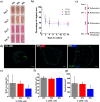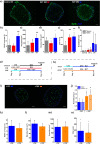Bioengineered human skeletal muscle capable of functional regeneration
- PMID: 33081771
- PMCID: PMC7576716
- DOI: 10.1186/s12915-020-00884-3
Bioengineered human skeletal muscle capable of functional regeneration
Abstract
Background: Skeletal muscle (SkM) regenerates following injury, replacing damaged tissue with high fidelity. However, in serious injuries, non-regenerative defects leave patients with loss of function, increased re-injury risk and often chronic pain. Progress in treating these non-regenerative defects has been slow, with advances only occurring where a comprehensive understanding of regeneration has been gained. Tissue engineering has allowed the development of bioengineered models of SkM which regenerate following injury to support research in regenerative physiology. To date, however, no studies have utilised human myogenic precursor cells (hMPCs) to closely mimic functional human regenerative physiology.
Results: Here we address some of the difficulties associated with cell number and hMPC mitogenicity using magnetic association cell sorting (MACS), for the marker CD56, and media supplementation with fibroblast growth factor 2 (FGF-2) and B-27 supplement. Cell sorting allowed extended expansion of myogenic cells and supplementation was shown to improve myogenesis within engineered tissues and force generation at maturity. In addition, these engineered human SkM regenerated following barium chloride (BaCl2) injury. Following injury, reductions in function (87.5%) and myotube number (33.3%) were observed, followed by a proliferative phase with increased MyoD+ cells and a subsequent recovery of function and myotube number. An expansion of the Pax7+ cell population was observed across recovery suggesting an ability to generate Pax7+ cells within the tissue, similar to the self-renewal of satellite cells seen in vivo.
Conclusions: This work outlines an engineered human SkM capable of functional regeneration following injury, built upon an open source system adding to the pre-clinical testing toolbox to improve the understanding of basic regenerative physiology.
Keywords: Regeneration; Satellite cell; Skeletal muscle; Tissue engineering.
Conflict of interest statement
The authors declare that they have no competing interests.
Figures





Similar articles
-
Functional regeneration of tissue engineered skeletal muscle in vitro is dependent on the inclusion of basement membrane proteins.Cytoskeleton (Hoboken). 2019 Jun;76(6):371-382. doi: 10.1002/cm.21553. Epub 2019 Aug 19. Cytoskeleton (Hoboken). 2019. PMID: 31376315 Free PMC article.
-
Bioengineered Skeletal Muscle as a Model of Muscle Aging and Regeneration.Tissue Eng Part A. 2021 Jan;27(1-2):74-86. doi: 10.1089/ten.TEA.2020.0005. Epub 2020 Jun 16. Tissue Eng Part A. 2021. PMID: 32364045 Free PMC article.
-
Inducing and Evaluating Skeletal Muscle Injury by Notexin and Barium Chloride.Methods Mol Biol. 2016;1460:53-60. doi: 10.1007/978-1-4939-3810-0_5. Methods Mol Biol. 2016. PMID: 27492165
-
Satellite cells: the architects of skeletal muscle.Curr Top Dev Biol. 2014;107:161-81. doi: 10.1016/B978-0-12-416022-4.00006-8. Curr Top Dev Biol. 2014. PMID: 24439806 Review.
-
Muscle stem cells in developmental and regenerative myogenesis.Curr Opin Clin Nutr Metab Care. 2010 May;13(3):243-8. doi: 10.1097/MCO.0b013e328336ea98. Curr Opin Clin Nutr Metab Care. 2010. PMID: 20098319 Free PMC article. Review.
Cited by
-
Uncovering the Embryonic Origins of Duchenne Muscular Dystrophy.WIREs Mech Dis. 2024 Nov-Dec;16(6):e1653. doi: 10.1002/wsbm.1653. Epub 2024 Oct 23. WIREs Mech Dis. 2024. PMID: 39444092
-
Myoblast deactivation within engineered human skeletal muscle creates a transcriptionally heterogeneous population of quiescent satellite-like cells.Biomaterials. 2022 May;284:121508. doi: 10.1016/j.biomaterials.2022.121508. Epub 2022 Apr 7. Biomaterials. 2022. PMID: 35421801 Free PMC article.
-
The Evolution of Complex Muscle Cell In Vitro Models to Study Pathomechanisms and Drug Development of Neuromuscular Disease.Cells. 2022 Apr 5;11(7):1233. doi: 10.3390/cells11071233. Cells. 2022. PMID: 35406795 Free PMC article. Review.
-
Extracellular vesicles may provide an alternative detoxification pathway during skeletal muscle myoblast ageing.J Extracell Biol. 2024 Aug 21;3(8):e171. doi: 10.1002/jex2.171. eCollection 2024 Aug. J Extracell Biol. 2024. PMID: 39169919 Free PMC article.
-
Inhibition of the Combinatorial Signaling of Transforming Growth Factor-Beta and NOTCH Promotes Myotube Formation of Human Pluripotent Stem Cell-Derived Skeletal Muscle Progenitor Cells.Cells. 2021 Jun 30;10(7):1649. doi: 10.3390/cells10071649. Cells. 2021. PMID: 34209364 Free PMC article.
References
Publication types
MeSH terms
Substances
Grants and funding
LinkOut - more resources
Full Text Sources
Research Materials
Miscellaneous

